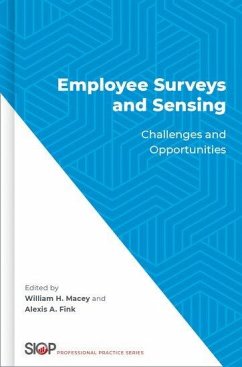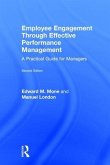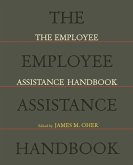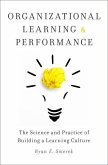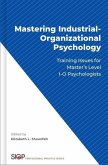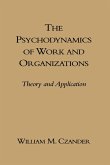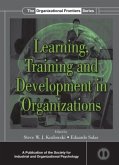Employee Surveys and Sensing
Challenges and Opportunities
Herausgeber: Macey, William H; Fink, Alexis A
Employee Surveys and Sensing
Challenges and Opportunities
Herausgeber: Macey, William H; Fink, Alexis A
- Gebundenes Buch
- Merkliste
- Auf die Merkliste
- Bewerten Bewerten
- Teilen
- Produkt teilen
- Produkterinnerung
- Produkterinnerung
This well-rounded presentation of the opportunities and challenges in conducting employee surveys or gathering sensing data brings together experts in employee surveys, employee engagement, organizational culture and climate, and research methodology. Coverage includes traditional survey approaches updated for changes in technology and employer concerns for continuous listening, as well as treatment of ambient sensing approaches and current thinking regarding applications of artificial intelligence. The book will be relevant to the professional community as well HR practitioners looking for…mehr
Andere Kunden interessierten sich auch für
![Employee Engagement Through Effective Performance Management Employee Engagement Through Effective Performance Management]() Edward MoneEmployee Engagement Through Effective Performance Management202,99 €
Edward MoneEmployee Engagement Through Effective Performance Management202,99 €![The Employee Assistance Handbook The Employee Assistance Handbook]() The Employee Assistance Handbook219,99 €
The Employee Assistance Handbook219,99 €![Organizational Learning & Performance C Organizational Learning & Performance C]() SmerekOrganizational Learning & Performance C86,99 €
SmerekOrganizational Learning & Performance C86,99 €![Mastering Industrial-Organizational Psychology Mastering Industrial-Organizational Psychology]() Mastering Industrial-Organizational Psychology110,99 €
Mastering Industrial-Organizational Psychology110,99 €![The Psychodynamics of Work and Organizations The Psychodynamics of Work and Organizations]() William M CzanderThe Psychodynamics of Work and Organizations74,99 €
William M CzanderThe Psychodynamics of Work and Organizations74,99 €![Learning, Training, and Development in Organizations Learning, Training, and Development in Organizations]() Learning, Training, and Development in Organizations194,99 €
Learning, Training, and Development in Organizations194,99 €![Career Pathways Career Pathways]() Career Pathways115,99 €
Career Pathways115,99 €-
-
-
This well-rounded presentation of the opportunities and challenges in conducting employee surveys or gathering sensing data brings together experts in employee surveys, employee engagement, organizational culture and climate, and research methodology. Coverage includes traditional survey approaches updated for changes in technology and employer concerns for continuous listening, as well as treatment of ambient sensing approaches and current thinking regarding applications of artificial intelligence. The book will be relevant to the professional community as well HR practitioners looking for critical background information on issues related to employee listening.
Hinweis: Dieser Artikel kann nur an eine deutsche Lieferadresse ausgeliefert werden.
Hinweis: Dieser Artikel kann nur an eine deutsche Lieferadresse ausgeliefert werden.
Produktdetails
- Produktdetails
- Verlag: Oxford University Press
- Seitenzahl: 504
- Erscheinungstermin: 22. April 2020
- Englisch
- Abmessung: 241mm x 166mm x 35mm
- Gewicht: 842g
- ISBN-13: 9780190939717
- ISBN-10: 0190939710
- Artikelnr.: 58410962
- Herstellerkennzeichnung
- Libri GmbH
- Europaallee 1
- 36244 Bad Hersfeld
- gpsr@libri.de
- Verlag: Oxford University Press
- Seitenzahl: 504
- Erscheinungstermin: 22. April 2020
- Englisch
- Abmessung: 241mm x 166mm x 35mm
- Gewicht: 842g
- ISBN-13: 9780190939717
- ISBN-10: 0190939710
- Artikelnr.: 58410962
- Herstellerkennzeichnung
- Libri GmbH
- Europaallee 1
- 36244 Bad Hersfeld
- gpsr@libri.de
William H. Macey, Ph.D., is Senior Research Fellow at CultureFactors, Inc. He was the CEO of Valtera Corporation for 35 years until the acquisition of Valtera by CEB in 2012. A SIOP past-president, he is a Fellow of SIOP, APA, and APS and was recipient of SIOP's Professional Contributions Award in 2017. He is a current member of the editorial board of the Journal of Business and Psychology. He received his Ph.D. from Loyola University Chicago in 1975 in Experimental Psychology. His current professional interests include organizational surveys, culture and climate, and leader assessment. Some of his more widely cited publications include "The Meaning of Employee Engagement" (Macey & Schneider, 2008); and "Employee Engagement: Tools for Analysis, Practice, and Competitive Advantage" (Macey, Schneider, Barbera & Young, 2009). Alexis A. Fink, Ph.D., is Vice President, People Analytics and Workforce Strategy at Facebook. She has previously held similar roles at Microsoft and Intel, and has done extensive work in organizational transformation, organizational culture, leadership assessment, and the application of advanced analytical methods to human capital problems. She is a Fellow of SIOP, a 2019 recipient of SIOP's Distinguished Service Award, and past Chair of the IT Survey Group, an industry consortium dedicated to employee surveys. She earned her Ph.D. in Industrial/Organizational Psychology at Old Dominion University in 2000. She also serves as the Practice Editor for Industrial and Organizational Psychology: Perspectives on Science and Practice.
* Chapter 1. Employee Surveys and Sensing: Challenges and Opportunities
* William H. Macey and Alexis A. Fink
* Chapter 2 Strategic Surveying for Driving Organizational Change: A
Very 3M Story
* Karen B. Paul and Kristofer J. Fenlason
* Chapter 3. Improving the Design and Interpretation of Sample Surveys
in the Workplace
* Paul M. Mastrangelo
* Chapter 4. Exploring the Universe of Pulse Surveys and Continuous
Listening Opportunities
* Jeffrey A. Jolton and Cameron Klein
* Chapter 5 Lifecycle Surveys: Individual and Organizational Journeys
* Jeffrey Saltzman, Scott Brooks, and Victoria Hendrickson
* Chapter 6 Design and Application of Employee Engagement Surveys: An
Evidence-Based Approach
* John P. Meyer
* Chapter 7. Focus Groups: Blending Qualitative and Quantitative
Methodology to Improve the Survey Process
* Jeffrey M. Cucina and Ilene F. Gast
* Chapter 8. Strategic Climate Research: How What We Know Should
Influence What We Do
* Benjamin Schneider
* Chapter 9. The Unique Role of Corporate Culture in Employee Listening
Systems
* Daniel Denison, Marcus Dickson, Michelle Mullins, and Jessie Sanchez
* Chapter 10. Employee Preferences: Why They Matter and How to Measure
Them
* Diane Daum and Jennifer Stoll
* Chapter 11. How Did We Do? Survey Benchmarking and Normative Data
* Elizabeth A. McCune and Sarah R. Johnson
* Chapter 12. Writing Organizational Survey Items that Predict What
Matters in Organizations
* Daniel Ingels, Kathryn Keeton, and Christiane Spitzmueller
* Chapter 13. Open-ended questions: The role of Natural Language
Processing and Text Analytics
* Subhadra Dutta and Eric O'Rourke
* Chapter 14. Is the Engagement Survey The Only Way? Alternative
Sources for Employee Sensing
* Madhura Chakrabarti and Elizabeth A. McCune
* Chapter 15. Mechanics of Survey Data Analysis
* Melinda J. Moye and Alison L. O'Malley
* Chapter 16. Taking Action to Drive Change through Survey Key Driver
Analysis
* Jeff W. Johnson
* Chapter 17. Linkage Analysis: Tying Employee Attitudes to Business
Outcomes
* Shawn Del Duco, Patrick Hyland, David Reeves, and Anthony Caputo
* Chapter 18. Optimizing Differences Between Groups is Important:
Examples from Applied Settings
* Paul Bliese, Eliza Wicher, and Dhuha "Dee" Abdulsallam
* Chapter 19. Data Visualization
* Evan F. Sinar
* Chapter 20. Creating and Delivering the Executive Presentation:
Telling the Story of the Survey
* Sarah R. Johnson
* Chapter 21. Artificial Intelligence-Augmented Action Taking
* Sara P. Weiner and Melissa McMahan
* Chapter 22. Rediscovering the Art of Surveys for Organization Change
* Allan H. Church and Melissa McMahan
* Chapter 23. Employee Survey Research: A Critical Review of Theory and
Practice
* Lewis Garrad and Patrick K. Hyland
* Chapter 24. From Identified Surveys to New Technologies: Employee
Privacy and Ethical Considerations
* Lise M. Saari and Charles A. Scherbaum
* Chapter 25. Managing Workplace Job Attitudes and Performance in
Organizations with Labor Unions
* Jim Harter and Denise McLain
* Chapter 26. Current and Future Trends in Employee Survey Practice: A
View from Employee Survey Practitioners
* Christopher T. Rotolo, Christina Fleck, and Brittnie Shepherd
* Chapter 27. Employee Surveys Move into the Future: A Tale of
Evolution, Revolution and Speed Bumps
* Allen I. Kraut
* William H. Macey and Alexis A. Fink
* Chapter 2 Strategic Surveying for Driving Organizational Change: A
Very 3M Story
* Karen B. Paul and Kristofer J. Fenlason
* Chapter 3. Improving the Design and Interpretation of Sample Surveys
in the Workplace
* Paul M. Mastrangelo
* Chapter 4. Exploring the Universe of Pulse Surveys and Continuous
Listening Opportunities
* Jeffrey A. Jolton and Cameron Klein
* Chapter 5 Lifecycle Surveys: Individual and Organizational Journeys
* Jeffrey Saltzman, Scott Brooks, and Victoria Hendrickson
* Chapter 6 Design and Application of Employee Engagement Surveys: An
Evidence-Based Approach
* John P. Meyer
* Chapter 7. Focus Groups: Blending Qualitative and Quantitative
Methodology to Improve the Survey Process
* Jeffrey M. Cucina and Ilene F. Gast
* Chapter 8. Strategic Climate Research: How What We Know Should
Influence What We Do
* Benjamin Schneider
* Chapter 9. The Unique Role of Corporate Culture in Employee Listening
Systems
* Daniel Denison, Marcus Dickson, Michelle Mullins, and Jessie Sanchez
* Chapter 10. Employee Preferences: Why They Matter and How to Measure
Them
* Diane Daum and Jennifer Stoll
* Chapter 11. How Did We Do? Survey Benchmarking and Normative Data
* Elizabeth A. McCune and Sarah R. Johnson
* Chapter 12. Writing Organizational Survey Items that Predict What
Matters in Organizations
* Daniel Ingels, Kathryn Keeton, and Christiane Spitzmueller
* Chapter 13. Open-ended questions: The role of Natural Language
Processing and Text Analytics
* Subhadra Dutta and Eric O'Rourke
* Chapter 14. Is the Engagement Survey The Only Way? Alternative
Sources for Employee Sensing
* Madhura Chakrabarti and Elizabeth A. McCune
* Chapter 15. Mechanics of Survey Data Analysis
* Melinda J. Moye and Alison L. O'Malley
* Chapter 16. Taking Action to Drive Change through Survey Key Driver
Analysis
* Jeff W. Johnson
* Chapter 17. Linkage Analysis: Tying Employee Attitudes to Business
Outcomes
* Shawn Del Duco, Patrick Hyland, David Reeves, and Anthony Caputo
* Chapter 18. Optimizing Differences Between Groups is Important:
Examples from Applied Settings
* Paul Bliese, Eliza Wicher, and Dhuha "Dee" Abdulsallam
* Chapter 19. Data Visualization
* Evan F. Sinar
* Chapter 20. Creating and Delivering the Executive Presentation:
Telling the Story of the Survey
* Sarah R. Johnson
* Chapter 21. Artificial Intelligence-Augmented Action Taking
* Sara P. Weiner and Melissa McMahan
* Chapter 22. Rediscovering the Art of Surveys for Organization Change
* Allan H. Church and Melissa McMahan
* Chapter 23. Employee Survey Research: A Critical Review of Theory and
Practice
* Lewis Garrad and Patrick K. Hyland
* Chapter 24. From Identified Surveys to New Technologies: Employee
Privacy and Ethical Considerations
* Lise M. Saari and Charles A. Scherbaum
* Chapter 25. Managing Workplace Job Attitudes and Performance in
Organizations with Labor Unions
* Jim Harter and Denise McLain
* Chapter 26. Current and Future Trends in Employee Survey Practice: A
View from Employee Survey Practitioners
* Christopher T. Rotolo, Christina Fleck, and Brittnie Shepherd
* Chapter 27. Employee Surveys Move into the Future: A Tale of
Evolution, Revolution and Speed Bumps
* Allen I. Kraut
* Chapter 1. Employee Surveys and Sensing: Challenges and Opportunities
* William H. Macey and Alexis A. Fink
* Chapter 2 Strategic Surveying for Driving Organizational Change: A
Very 3M Story
* Karen B. Paul and Kristofer J. Fenlason
* Chapter 3. Improving the Design and Interpretation of Sample Surveys
in the Workplace
* Paul M. Mastrangelo
* Chapter 4. Exploring the Universe of Pulse Surveys and Continuous
Listening Opportunities
* Jeffrey A. Jolton and Cameron Klein
* Chapter 5 Lifecycle Surveys: Individual and Organizational Journeys
* Jeffrey Saltzman, Scott Brooks, and Victoria Hendrickson
* Chapter 6 Design and Application of Employee Engagement Surveys: An
Evidence-Based Approach
* John P. Meyer
* Chapter 7. Focus Groups: Blending Qualitative and Quantitative
Methodology to Improve the Survey Process
* Jeffrey M. Cucina and Ilene F. Gast
* Chapter 8. Strategic Climate Research: How What We Know Should
Influence What We Do
* Benjamin Schneider
* Chapter 9. The Unique Role of Corporate Culture in Employee Listening
Systems
* Daniel Denison, Marcus Dickson, Michelle Mullins, and Jessie Sanchez
* Chapter 10. Employee Preferences: Why They Matter and How to Measure
Them
* Diane Daum and Jennifer Stoll
* Chapter 11. How Did We Do? Survey Benchmarking and Normative Data
* Elizabeth A. McCune and Sarah R. Johnson
* Chapter 12. Writing Organizational Survey Items that Predict What
Matters in Organizations
* Daniel Ingels, Kathryn Keeton, and Christiane Spitzmueller
* Chapter 13. Open-ended questions: The role of Natural Language
Processing and Text Analytics
* Subhadra Dutta and Eric O'Rourke
* Chapter 14. Is the Engagement Survey The Only Way? Alternative
Sources for Employee Sensing
* Madhura Chakrabarti and Elizabeth A. McCune
* Chapter 15. Mechanics of Survey Data Analysis
* Melinda J. Moye and Alison L. O'Malley
* Chapter 16. Taking Action to Drive Change through Survey Key Driver
Analysis
* Jeff W. Johnson
* Chapter 17. Linkage Analysis: Tying Employee Attitudes to Business
Outcomes
* Shawn Del Duco, Patrick Hyland, David Reeves, and Anthony Caputo
* Chapter 18. Optimizing Differences Between Groups is Important:
Examples from Applied Settings
* Paul Bliese, Eliza Wicher, and Dhuha "Dee" Abdulsallam
* Chapter 19. Data Visualization
* Evan F. Sinar
* Chapter 20. Creating and Delivering the Executive Presentation:
Telling the Story of the Survey
* Sarah R. Johnson
* Chapter 21. Artificial Intelligence-Augmented Action Taking
* Sara P. Weiner and Melissa McMahan
* Chapter 22. Rediscovering the Art of Surveys for Organization Change
* Allan H. Church and Melissa McMahan
* Chapter 23. Employee Survey Research: A Critical Review of Theory and
Practice
* Lewis Garrad and Patrick K. Hyland
* Chapter 24. From Identified Surveys to New Technologies: Employee
Privacy and Ethical Considerations
* Lise M. Saari and Charles A. Scherbaum
* Chapter 25. Managing Workplace Job Attitudes and Performance in
Organizations with Labor Unions
* Jim Harter and Denise McLain
* Chapter 26. Current and Future Trends in Employee Survey Practice: A
View from Employee Survey Practitioners
* Christopher T. Rotolo, Christina Fleck, and Brittnie Shepherd
* Chapter 27. Employee Surveys Move into the Future: A Tale of
Evolution, Revolution and Speed Bumps
* Allen I. Kraut
* William H. Macey and Alexis A. Fink
* Chapter 2 Strategic Surveying for Driving Organizational Change: A
Very 3M Story
* Karen B. Paul and Kristofer J. Fenlason
* Chapter 3. Improving the Design and Interpretation of Sample Surveys
in the Workplace
* Paul M. Mastrangelo
* Chapter 4. Exploring the Universe of Pulse Surveys and Continuous
Listening Opportunities
* Jeffrey A. Jolton and Cameron Klein
* Chapter 5 Lifecycle Surveys: Individual and Organizational Journeys
* Jeffrey Saltzman, Scott Brooks, and Victoria Hendrickson
* Chapter 6 Design and Application of Employee Engagement Surveys: An
Evidence-Based Approach
* John P. Meyer
* Chapter 7. Focus Groups: Blending Qualitative and Quantitative
Methodology to Improve the Survey Process
* Jeffrey M. Cucina and Ilene F. Gast
* Chapter 8. Strategic Climate Research: How What We Know Should
Influence What We Do
* Benjamin Schneider
* Chapter 9. The Unique Role of Corporate Culture in Employee Listening
Systems
* Daniel Denison, Marcus Dickson, Michelle Mullins, and Jessie Sanchez
* Chapter 10. Employee Preferences: Why They Matter and How to Measure
Them
* Diane Daum and Jennifer Stoll
* Chapter 11. How Did We Do? Survey Benchmarking and Normative Data
* Elizabeth A. McCune and Sarah R. Johnson
* Chapter 12. Writing Organizational Survey Items that Predict What
Matters in Organizations
* Daniel Ingels, Kathryn Keeton, and Christiane Spitzmueller
* Chapter 13. Open-ended questions: The role of Natural Language
Processing and Text Analytics
* Subhadra Dutta and Eric O'Rourke
* Chapter 14. Is the Engagement Survey The Only Way? Alternative
Sources for Employee Sensing
* Madhura Chakrabarti and Elizabeth A. McCune
* Chapter 15. Mechanics of Survey Data Analysis
* Melinda J. Moye and Alison L. O'Malley
* Chapter 16. Taking Action to Drive Change through Survey Key Driver
Analysis
* Jeff W. Johnson
* Chapter 17. Linkage Analysis: Tying Employee Attitudes to Business
Outcomes
* Shawn Del Duco, Patrick Hyland, David Reeves, and Anthony Caputo
* Chapter 18. Optimizing Differences Between Groups is Important:
Examples from Applied Settings
* Paul Bliese, Eliza Wicher, and Dhuha "Dee" Abdulsallam
* Chapter 19. Data Visualization
* Evan F. Sinar
* Chapter 20. Creating and Delivering the Executive Presentation:
Telling the Story of the Survey
* Sarah R. Johnson
* Chapter 21. Artificial Intelligence-Augmented Action Taking
* Sara P. Weiner and Melissa McMahan
* Chapter 22. Rediscovering the Art of Surveys for Organization Change
* Allan H. Church and Melissa McMahan
* Chapter 23. Employee Survey Research: A Critical Review of Theory and
Practice
* Lewis Garrad and Patrick K. Hyland
* Chapter 24. From Identified Surveys to New Technologies: Employee
Privacy and Ethical Considerations
* Lise M. Saari and Charles A. Scherbaum
* Chapter 25. Managing Workplace Job Attitudes and Performance in
Organizations with Labor Unions
* Jim Harter and Denise McLain
* Chapter 26. Current and Future Trends in Employee Survey Practice: A
View from Employee Survey Practitioners
* Christopher T. Rotolo, Christina Fleck, and Brittnie Shepherd
* Chapter 27. Employee Surveys Move into the Future: A Tale of
Evolution, Revolution and Speed Bumps
* Allen I. Kraut

